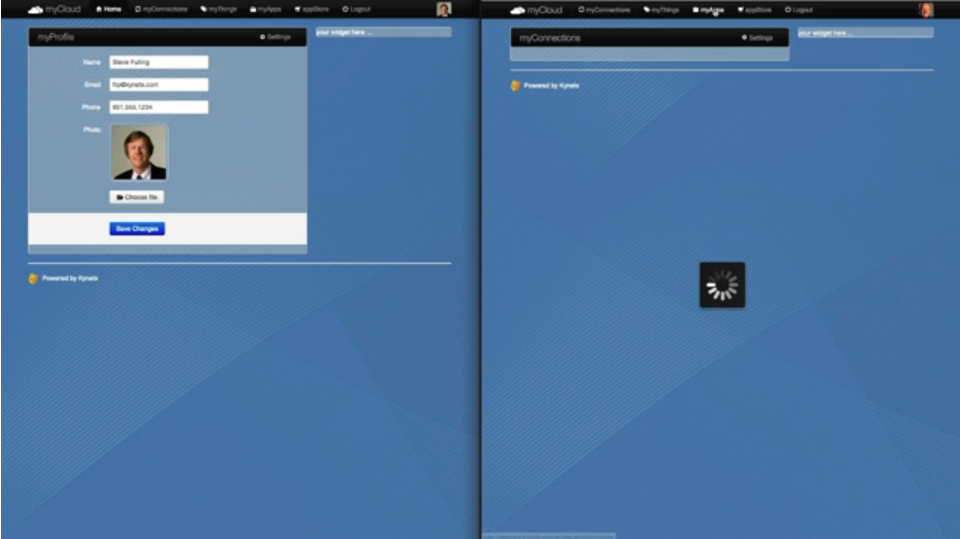Summary
Personal clouds are accessed and configured using a cloud-based desktop that can be accessed from any device at any time. This screencast shows the personal cloud desktop in action as two clouds are linked via subscription.

I've been asked how people will interact with personal clouds. My answer is a desktop of sorts that lets the owner interact with and configure applications. The desktop is also where owners manage subscriptions between their cloud and the clouds of other people, organizations, places and things. I've created a video that shows how subscriptions work between personal clouds. in the screencast, you can see a desktop—actually two—in action. I've embedded it here, but you'll probably get more out of it, if you click out and watch it in a larger size.
This desktop lives in the cloud and is thus accessible from anywhere on any device. In this screencast, both Steve and Phil are using similar desktops, but that isn't required. I expect that vendors will differentiate themselves, in part, on the basis of their desktop.
A few comments:
- The subscriptions are decentralized and based on HTTP using the Evented API specification and event channels. Nothing magic or proprietary. Everything is pretty straightforward underneath the covers.
- The subscriptions are being done without permissioning at this point to make demos easier. The final product will allow both sides to agree to the subscription.
- We're only showing symmetric, peer-to-peer relationships in this demonstration. Asymmetric subscriptions are also possible, but not shown here. Also, the permissions and relationship that you have with things you own would be different. I'll show that in a few weeks.
- All of the apps and functionality in the screencast are real. Nothing has been dummied up for purposes of the demo. The apps paint the screen using a desktop service that manages the desktop. I'll have more details about that soon.
- The personal clouds are not purpose-built: Adding new functionality is as simple as installing new apps. While the underlying architecture is the same, a cloud for a personal, organization, place, or thing can be customized for the specific purpose. For example, rather than a Profile app, the personal cloud for my car would have a SquareTag app that supports the same event interactions, but with a schema that's appropriate for a car instead of a person.
While simple, this screencast represents a major step forward in making personal clouds and the CloudOS real. We're making strong progress and I expect that I'll have lots more to show you over the coming few weeks.
Here's the dialogue from the screencast if you'd rather read it:
This screencast shows the Personal Cloud desktop in action. We're going to link two personal clouds through a subscription and then show how one can make use of the profile information in the other.
On the left is the desktop for Steve Fulling, on the right is the desktop for Phil Windley. Each desktop is tied to a different personal cloud. Steve's desktop is showing the Profile app. Phil's desktop is showing his connections. Currently he has none.
Phil clicks on MyApps. He has a number of apps installed in his personal cloud. He launches the WhitePages app to see a directory of other personal cloud users. The directory is just one way one personal cloud user might find another. Phil clicks on Steve's picture, creating a symmetric relationship between the two clouds.
Now when he visits his connections, we can see that he is connected to Steve.
Phil uses the connection to send an email to Steve.
We can see that the address he gets in his email application is the same one Steve has in his profile.
Now let's go over to Steve's personal cloud and update his email from flip@kynetx.com to zlop@kynetx.com.
After saving the changes, we can go back to Phil's cloud.
Now when Phil sends an email to Steve, he gets the new email address. The profile change has been sent to all of Steve's connections.
Over on Steve's cloud, let's sever the connection to Phil by going to Steve's connections and unsubscribing.
We can see that the connection is removed from both Steve and Phil's personal clouds.
Steve can have as many connections as he likes between his personal cloud and other clouds. Each is a separate, distinct connection that can be managed independently. The Personal Cloud desktop gives him a way to control these connections.




